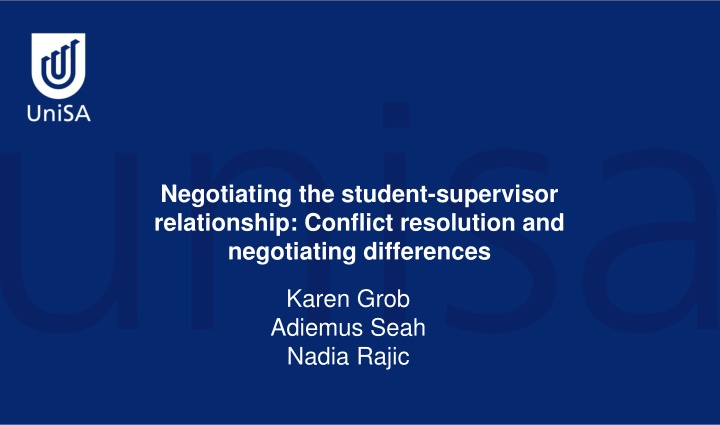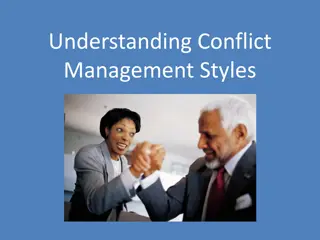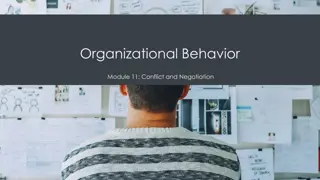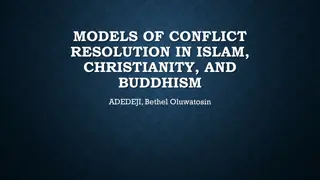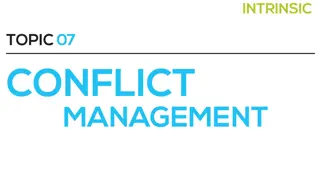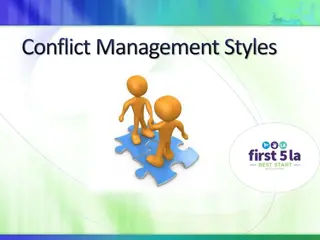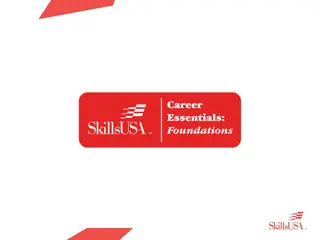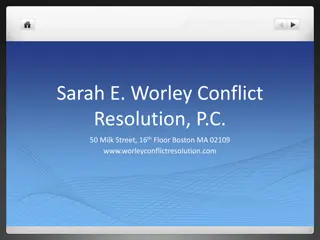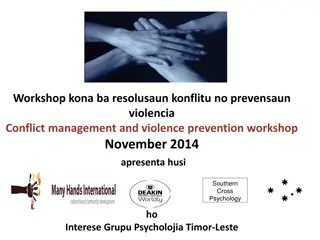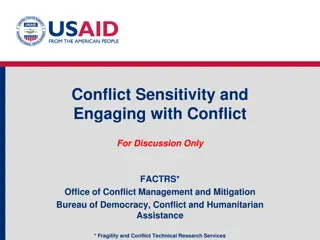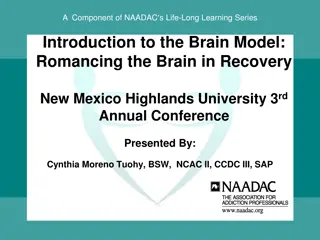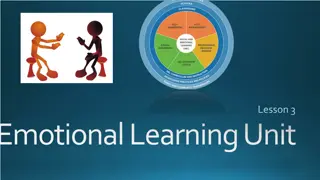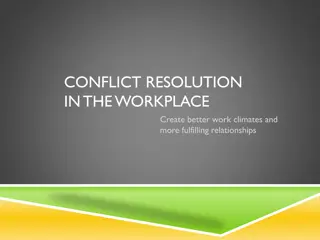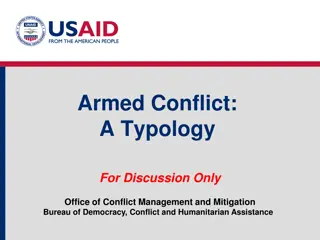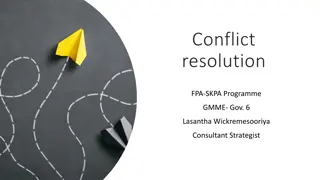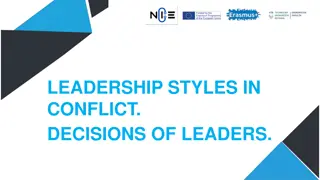Negotiating Student-Supervisor Relationship: Conflict Resolution & Differences
Define conflict in student-supervisor dynamics, explore constructive approaches to conflict, and discuss useful strategies for resolving conflicts effectively. Learn a model for conflict resolution stages.
Download Presentation

Please find below an Image/Link to download the presentation.
The content on the website is provided AS IS for your information and personal use only. It may not be sold, licensed, or shared on other websites without obtaining consent from the author.If you encounter any issues during the download, it is possible that the publisher has removed the file from their server.
You are allowed to download the files provided on this website for personal or commercial use, subject to the condition that they are used lawfully. All files are the property of their respective owners.
The content on the website is provided AS IS for your information and personal use only. It may not be sold, licensed, or shared on other websites without obtaining consent from the author.
E N D
Presentation Transcript
Negotiating the student-supervisor relationship: Conflict resolution and negotiating differences Karen Grob Adiemus Seah Nadia Rajic
Workshop Aims To provide you with: an understanding of conflict useful approaches to conflict resolution policy and procedures for student complaints and grievances the role of mental health and well-being
Understanding Conflict Conflict can simply be defined as: when two or more people have currently incompatible goals when two or more people cannot agree but need to make a decision when one person feels personal rights have been violated (McGrath & Edwards 2000)
Approaches to Conflict Non-constructive Constructive Conflict can also be creative and constructive. Conflict can: promote new ideas strengthen relationships encourage interpersonal communication stimulate individual growth facilitate the examination of problems Conflict is often regarded as negative, destructive and undesirable. Conflict can: hinder communication interfere with relationships increase problems erect barriers
Your Concerns Small group activity questions Over the next 10 minutes, discuss the following questions in groups of 2 people: 1. What are the real or possible conflict scenarios for you as an supervisor? 2. What strategies have you found useful in dealing with conflict?
Some useful strategies Focus on the problem, not the person Focus on requirements, not positions Emphasise common ground: be inventive about options Manage your emotions: respond not react Make clear agreements
A Useful Model of CR Models or stages offer a useful checklist for resolving conflict. In general, the following 10 stages will be worked through: 1. Agreement on the conflict 2. Agreement on the process 3. Agreement on a plan for resolution (the 3 Agrees) 4. Sharing perceptions 5. Responding (Share/Respond model)
A Useful Model of CR 6. Defining objectives 7. Exploring option(s) 8. Selecting option(s) 9. Implementing 10. Evaluating and reviewing (DESIE model) (Adapted from Tillett 1999)
A Useful Model of CR AAA The 3 Agrees SR Share/Respond DESIE Move to desired outcome
1. Agreement on the Conflict What is the conflict? Often conflict is imprecisely defined e.g. We have a poor working relationship . Identify the conflict(s) precisely and specifically Phrase in neutral, objective terms
2. Agreement on the Process This agreement may include: Agreement to work it out together Agreement to seek assistance from a third party (e.g. student advocate, coordinator) When to meet, where, how the discussion will be arranged, degree of formality, what ground rules will apply (no accusations, attacks, blaming, name- calling)
Grievance Processes Policy and Procedures for student complaints and grievances. See C-17.4 Student Complaints Resolution: http://w3.unisa.edu.au/policies/policies/corporate/C17.asp Mediation Conciliation Arbitration Question: What is your knowledge of the UniSA student complaints resolution policy?
Grievance Processes Procedures for managing unsatisfactory progress in higher degree by research students: http://w3.unisa.edu.au/policies/policies/resrch/res10-regs.asp#9. Code of good practice: research degrees management and supervision (roles and responsibilties of students and supervisors: http://w3.unisa.edu.au/policies/codes/goodprac/mansupvising.asp USASA Student Advocacy Student Ombud: http://w3.unisa.edu.au/ombud/default.asp
3. Agreement on a Plan for Resolution The desired outcome of the process is to make a plan for resolution. The plan: Can be presented as a proposal that is realistic and flexible Can be referred to as a possible resolution Needs to include review and revision Annual Review of Progress
4.Sharing Perceptions Understanding the other person s point of view is a key in conflict resolution Understanding does not mean agreeing with, approving of, or even accepting what he or she says. It only means that you are registering their view point can have a powerful effect on minimising negative emotions You feel like you ve reached your limit, is that right?
4.Sharing Perceptions EXPLORE to unfold the difficulty in more depth Ask general open-ended questions that encourage the person to open up e.g. How do you see it all? Ask specific questions that will give you significant pieces of information
5.Responding Responding to a complaint or attack on you. Aim of speaker: to tell you that you are the problem. Task of listener: to let them know that you ve taken in what they are saying and to defuse the strong emotion
5.Responding Don t defend yourself initially Deal with their emotions first Make sure they know they are being heard name the emotions Acknowledge their side register their viewpoint e.g. I can see , if you think that was my attitude, why you are so angry.
6.Defining Objectives Define objectives in specific, practical and achievable terms Include some basic objectives. Focus on future action How would you like it to be? Is that possible? What would it take?
7.Exploring Option(s) What are the range of options available? Brainstorm ideas and possibilities Record the options (e.g. visually)
8.Selecting Option(s) Negotiation is most effectively undertaken by talking possibilities and proposals in language that is tentative e.g. possibly, perhaps, could, might Apply an if then process If we select this option, then ..
9.Implementing Both parties must clearly and precisely understand: what has been agreed what they are required to do what they can expect from the other person Plan who will do what, where and by when Document this information
10.Evaluating and Reviewing It is useful to arrange a follow-up meeting or series of meetings to monitor and evaluate whether the proposal has been implemented effectively
10.Evaluating and Reviewing If the proposal has not worked, then reasons need to be identified. It is useful to consider the options again or review the implementation and revise it
Case studies Please refer to case study 1 and 2 in your handouts (Amanda and Ali)
11. Conflict management and mental health The long term nature of the student-supervisor relationship, and the stress often associated with the requirements of doctoral study, can have implications for a student s mental health. Stress in the student-supervisor relationship, as well as external peer relationships, can also contribute to anxiety and depression.
11. Conflict management and mental health Anxiety can manifest in multiple ways and can include behaviours such as becoming angry or irritated easily; trouble with concentration; difficulty with feeling positive emotions; feelings of helplessness and lack of interest in things that used to bring joy. Depression also manifests in multiple ways and can include behaviours of procrastination, avoiding work- related issues, lack of concentration, irritability, indecisiveness and feeling overwhelmed and/or helpless or worthless.
Indicators of Distress in Students Behaviours Absenteeism and going off the radar Examples of what to look for Non-attendance, non-participation Procrastination, reduced motivation Inability to take steps (eg extensions) Upset and crying, pessimism or reduced confidence Anxiety Erratic behaviour and/or aggression Obvious display of tears, reduced eye contact, self criticism, negative Non-attendance, fidgeting, worried Verbal abruptness, fidgeting or restless Depression Discouraged, hopeless, sad, deterioration in appearance, talking about ending it all Self disclosure, excessive contact Over-reliance on Supervisor
Suggestions If you are concerned about a student you could say Are you okay? I don t want to be intrusive, but I just want to ask you how you re going? I ve been a bit concerned about you. I m wondering how you re travelling. I ve noticed some change(s) in .....
Responding to Students Stay calm particularly in crisis situations Clarify what is most concerning them right now Consider what you can do and be clear and consistent with the student Maintain professional boundaries Consider what others can do (eg Counsellor) and refer Follow up with the student
How to refer students Give the student a card or brochure for the LTU Counselling Service and/or Disability Service Suggest the student call the LTU on their home campus Offer to call the LTU to make an appointment for the student or bring them in to make appointment Provide details of UnisaMedical for referral to GP For urgent referrals bring the student into the LTU or contact Security
Case study 3 Please refer to case study 3 in your handouts that focuses on mental health and well-being.
Feedback Evaluations Thank you from the Learning and Teaching Unit (LTU)
